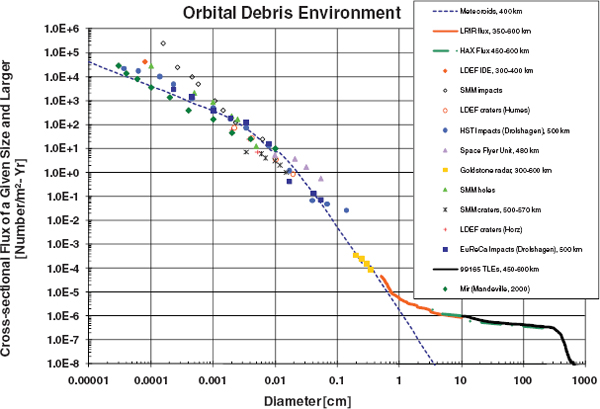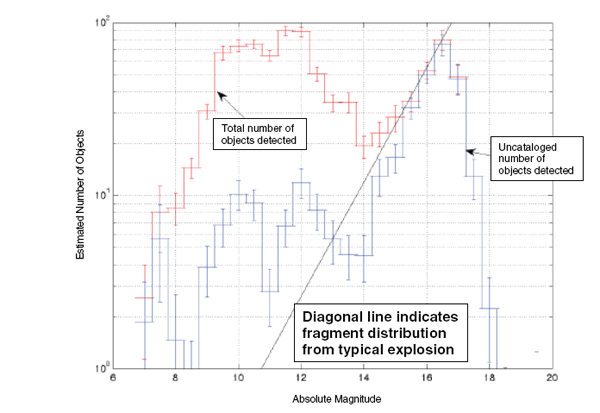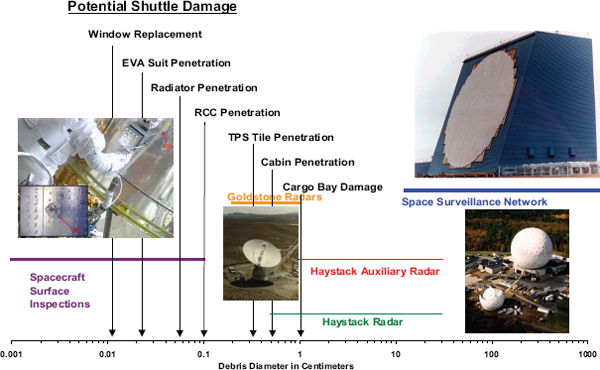2
Orbital Debris Environment: Detection and Monitoring
Objects in the orbital debris environment are detected and monitored by a combination of remote and in situ measurements, and ground tests are used to help interpret those measurements. Calibration and analysis are required to interpret the measurements of the MMOD environment in terms of common parameters, usually impact flux (number per area per unit time) as a function of mass or diameter in various regions of space. Although parts of the NASA MMOD programs rely on measurements used to maintain the U.S. Strategic Command (USSTRATCOM) satellite catalog, NASA’s primary program for measurement of debris uses sensors that sample only a portion of the debris environment, and the program performs a statistical analysis of the data to estimate the number of objects. That is, the sensors measure the number of objects per unit of time passing through a relatively small, but defined, volume of space. Orbital telemetry elements of objects in the catalog are converted to flux,1 and this calculated flux can then be compared to the measured flux to test sensor calibration.
Orbital debris and meteoroids less than 10 cm in size in low Earth orbit (LEO) are measured with ground-based telescopes and radar and by examining the surfaces of returned spacecraft. Each type of sensor is capable of detecting debris of increasingly smaller sizes. Figure 2.1 compares the current measured orbital debris flux with the meteoroid flux for altitudes below 600 km. Both radar and optical measurements show an orbital debris flux increasing with altitude, up to 900 km, where the flux of 1-cm debris is measured by Haystack as being about 10 times larger than that indicated by optical measurements. At geosynchronous Earth orbit (GEO) altitudes, ground radar and telescopes are used to track the orbital debris environment, where the cataloged sizes are larger than 1 meter. Figure 2.2 illustrates the number of uncataloged objects detected near GEO by the Michigan Orbital Debris Survey Telescope (MODEST), a telescope located in Chile and configured to look for uncataloged objects.2 Although the cataloged population in LEO contains all debris above 10 cm in size, in GEO the detection threshold for the satellite catalog is about 1 m.
The flux of orbital debris of the smallest sizes (less than about 1 mm) is obtained by analyzing the surfaces of satellites returned to Earth. The major uncertainty with these measurements lies in relating the damage measured on a particular returned surface to the damage measured on other types of surfaces or structures. This uncertainty is reduced through hypervelocity testing of various types of surfaces and structures. However, data of this type has been limited to impacts at altitudes below 600 km, the upper limit of space shuttle operations. For debris of larger
___________________
1 Kessler, D.J., Derivation of the collision probability between orbiting objects: The lifetimes of Jupiter’s outer moons, Icarus 48:39-48, 1981.
2 NASA Orbital Debris Program Office, Orbital Debris Mitigation and Reentry Risk Management Course, NASA Johnson Space Center, Houston, Tex., 2010.

FIGURE 2.1 Measurements of orbital debris below 600 km are compared to the meteoroid flux at altitudes below 600 km. The orbital debris measurements (in some cases, averaged over several altitudes below 600 km) reflect use of the cataloged objects (99165 two-line elements), Haystack Auxiliary (HAX) radar, Haystack Long Range Imaging Radar, Goldstone radar, and returned spacecraft surfaces. At higher altitudes, the orbital debris flux increases with altitude, up to 900 km, where HAX has measured the flux of 1-cm objects as being about 10 times larger. The meteoroid flux remains nearly constant over this region. SOURCE: Courtesy of NASA-JSC, from Orbital Debris Program Office, “APPEL Orbital Debris Mitigation & Reentry Risk Management Course,” CD, NASA Johnson Space Center, Houston, Tex., 2010, Part 1B, pp. 18 and 27.
sizes (between 2 mm and 10 cm in LEO), an exposed surface larger than that of a typical satellite is required to obtain a meaningful sample of “impacts,” so ground telescopes and short-wavelength radars are used. However, neither telescopes nor radars actually track the objects that are detected; rather, they stay in a “staring mode” that essentially counts the number of objects passing through their relatively small field of view. While the debris is in the field of view, its direction of motion, signal strength, and range (for radar) or angular velocity (for telescopes) are measured. The largest source of uncertainty with these sensors exists in interpreting the signal strength in terms of the size or mass of the object passing through the field of view.
Signal strength is reported by telescopes in units of stellar magnitude, and by radar as radar cross section (RCS). Stellar magnitude is related to RCS statistically by using a sample of small fragments in which both RCS and magnitude are measured for each object.3 An advantage of detecting uncataloged debris with both radars and telescopes is finding debris that may not be seen by one or the other alone. In 1995, NASA began operations of the NASA-built and NASA-designed 3-meter Liquid Mirror Telescope (LMT). However, as a result of budget cuts, the LMT was shut down in 2001. Although the LMT was providing useful data on uncataloged debris, the amount of debris found was less than predicted as a result of its lower than expected albedo. The decision to discontinue opera-
___________________
3 D.J. Kessler and K.S. Jarvis, Obtaining the properly weighted average albedo of orbital debris from optical and radar data, Advances in Space Research 34(5):1006-1012, 2004.

FIGURE 2.2 Uncataloged objects detected by MODEST compared to a total detected population near geosynchronous Earth orbit (GEO) altitude, indicating a significant population of objects in GEO that are uncataloged, possibly as a result of explosions near GEO. The diagonal line represents what the size of the population might be as the result of an explosion in GEO and suggests that such an event may be the source of this smaller debris; however, further analysis and observation will have to be performed to determine the source of these uncataloged objects and whether the size distribution will continue along this line for absolute magnitudes larger than 16. SOURCE: Adapted, courtesy of NASA-JSC, from Orbital Debris Program Office, “APPEL Orbital Debris Mitigation & Reentry Risk Management Course,” CD, NASA Johnson Space Center, Houston, Tex., 2010, Part 1B, pp. 18 and 27.
tions of the LMT left only the remote observations using radar, which continue today and have become the most important technique for monitoring the debris environment for debris ranging in size between 2 mm and 10 cm.
NASA’s orbital debris monitoring efforts currently receive data from three radars: Haystack (debris to 6 mm) and Haystack Auxiliary (HAX) (to 2 cm) in Westford, Massachusetts, and Goldstone (to 2 mm) in California’s Mojave Desert. Following a significant debris-producing event, these radars are oriented to measure the flux of small debris produced in the stream of fragments generated by the event in order to test the debris source models. The most important limitation of these radars is their location; their higher latitude limits to orbital inclinations greater than about 28 degrees any observations of uncataloged debris; in addition, debris from objects in a Molniya-type orbit (which is highly elliptical, with an apogee near geosynchronous altitude and a perigee in the Southern Hemisphere) cannot be detected, because most of the U.S. ground-based sensor systems are in the Northern Hemisphere. Some of the limitations with respect to observational inclination will be resolved with remote operations by NASA of the Meter-Class Autonomous Telescope (MCAT) at Kwajalein Atoll in the Pacific Ocean beginning in 2012. This low-latitude location will permit detection of uncataloged debris at low inclinations, although not to sizes as small as can be detected by current radar capabilities. MCAT will also detect GEO debris as small as 10 cm.
The major uncertainty in these measurements is in relating RCS to the physical characteristics of the debris.
Ground tests combined with radar calibrations have been used to address this issue. Between 1991 and 1992, DOD conducted a series of hypervelocity tests to simulate the hypervelocity breakup of a payload, known as the Satellite Orbital Debris Characterization Impact Test (SOCIT) series. In the fourth and final test, a flight-ready, 35-kg transit payload was hit with a 150-g projectile at 6 km/s.4 The results of that test not only helped shape future debris breakup models for the LEGEND (LEO-to-GEO Environment Debris) model, but also supplied a number of fragments that could be used to measure RCS on a radar range, under the assumption that the fragments had physical characteristics similar to those of fragments in orbit. The results were a distribution of possible RCS returns from objects having a particular size, mass, and shape. From these distributions, an orbital debris size estimation algorithm (also known as the Size Estimation Model, or SEM) was developed to relate RCS to size.5
Limitations of the SEM became obvious when the Haystack radar begin to discover new sources of debris. The most-verified new source of debris was droplets of sodium potassium (NaK) from Russian radar ocean reconnaissance satellites. Using the SEM, it was concluded that 60 kg of NaK were in orbit.6 Since these droplets are simply liquid-metal spheres, they each have a well-understood RCS that depends only on their size. When an algorithm was applied to the measured RCS distribution of NaK objects, their total mass was calculated at 150 kg.7 The reason for the difference in total mass is that the RCS is larger for objects with certain orientations than for any metal sphere of the same size. Consequently, the SEM includes biases toward smaller objects when a large number of smaller-size objects are known to exist.
The Haystack radar also discovered objects with orbital characteristics expected for aluminum oxide slag from solid-rocket-motor exhaust8—particles that would likely be nearly spherical but non-metallic. Little data exists on the amount of slag that solid-rocket motors are likely to produce or on their expected RCS. Other sources of debris, such as fragments from upper-stage rockets and satellites made of a larger range of materials, were not included in the sample of objects used to establish the SEM. Obtaining samples of these fragments requires a ground test program similar to the 1991 to 1992 series of SOCIT tests, and such a test program does not currently exist.
The SEM is important to both the Orbital Debris Environment Model (ORDEM), which must correctly convert RCS to size of debris and hazard, and to the LEGEND model, which must properly capture the relative contributions of various sources of debris to help NASA “lead the continued development and adoption of international and industry standards and policies to minimize debris, such as the United Nations Space Debris Mitigation Guidelines” (p. 7) as required in the 2010 National Space Policy.
Finding: The current lack of radar cross-section calibrations for fragments from a larger range of materials used in modern satellites and rocket bodies, as well as non-fragmentation debris, represents a significant source of uncertainty in interpreting key measurements of the orbital debris environment.
Figure 2.3 summarizes the capabilities of the sensors on which the NASA orbital debris programs depend to define the orbital debris environment and summarizes the types of damage that debris of different sizes can cause. Missing from the orbital debris monitoring program is a capability to monitor the flux of debris smaller than 2 mm in size as a function of both time and altitude. Lessons can be learned by reflecting on the early research done during the 1960s to understand the meteoroid hazard.
Like the flux for orbital debris, the flux for meteoroids larger than a few millimeters has been determined using
___________________
4 D.M. Hogg, T.M Cunningham, and W.M. Isbell, Final Report on the SOCIT Series of Hypervelocity Impact Tests, Report No. WL-TR-93-7025, Wright Laboratory, Armament Directorate, Wright-Patterson Air Force Base, Ohio, July 1993.
5 E.G. Stansbery, C.C. Pitts, G. Bohannon, et al., Size and Orbit Analysis of Orbital Debris Data Collected Using the Haystack Radar, NASA JSC-25245, NASA Johnson Space Center, Houston, Tex., 1991.
6 D.J. Kessler, M.J. Matney, R.C. Reynolds, R.P. Bernhard, E.G. Stansbery, N.L. Johnson, A.E. Potter, and P.D. Anz-Meador, “A Search for a Previously Unknown Source of Orbital Debris: The Possibility of a Coolant Leak in Radar Ocean Reconnaissance Satellites,” IAA-97IAA.6.3.03, presented at the 48th International Astronautical Conference, Turin, Italy, October 6-10, 1997 (also pp. 129-150 in Space Safety and Rescue 1997 (G.W. Heath, ed.), Science and Technology Series, Volume 96, American Astronautical Society, Springfield, Va.).
7 P. Krisko, NASA’s sodium potassium generation and propagation model, Orbital Debris Quarterly News 8(1):6-7, 2004, available at http://orbitaldebris.jsc.nasa.gov/newsletter/pdfs/ODQNv8i1.pdf, accessed July 7, 2011.
8 D.J. Kessler, N. Johnson, E. Stansbery, R. Reynolds, K. Siebold, M. Matney, and A. Jackson, The importance of non-fragmentation sources of debris to the environment, Advances in Space Research 23(1):149-159, 1999.

FIGURE 2.3 Orbital debris program sensor capabilities for low Earth orbit orbital debris measurements. The capabilities for characterization of small debris are a function of returned samples and a variety of remote measurement capabilities. The importance of these size ranges is highlighted by their associated potential effects on space shuttle subsystem reliability. SOURCE: Adapted, courtesy of NASA, from Lyver, J., “NASA Micrometeoroid and Orbital Debris Program Overview to National Research Council,” presentation to the Committee for the Assessment of NASA’s Orbital Debris Programs, December 13, 2010, National Research Council, Washington, D.C., p. 10.
remote observations, in the case of meteoroids by measuring the meteor ion trail in Earth’s atmosphere. Smaller-size meteoroids have been measured using a multitude of in situ sensors on satellites. Similar to the situation with measurements of orbital debris, there has been more uncertainty in the remote sensing data for meteoroids than in the in situ data. The in situ data from satellites such as the three Pegasus satellites launched in 1965 has turned out to be critical in helping to resolve uncertainties in the remotely sensed data and was a major component in defining the parameters in meteoroid environment models used today. Given uncertainty in the current RCS calibrations, in situ data are also likely to be a major component in defining parameters in models of the orbital debris environment.
Although no major changes from 1960s in situ measurements of the background meteoroid flux have been detected, that is not the expectation for the orbital debris environment, which is predicted to be, and has been measured to be, much more dynamic than the meteoroid environment. Ironically, dynamic changes in the orbital debris environment were measured as a result of an experiment on the Long Duration Exposure Facility, which was intended to detect meteoroid streams. Instead of meteoroid steams, most of the 15,000 impacts detected were interpreted as being the result of Earth-orbiting debris streams.9 The source of those debris streams is still uncertain, although some streams have been associated with solid rocket motors. In addition to helping to confirm RCS calibrations, the much higher flux measured with in situ instrumentation will translate to more quickly monitoring
___________________
9 J.P. Oliver, S.F. Singer, J.L. Weinberg, C.G. Simon, W.J. Cooke, P.C. Kassel, W.H. Kinard, J.D. Mulholland, and J.J. Wortman, LDEF Interplanetary Dust Experiment (IDE) results, pp. 353-360 in LDEF—69 Months in Space, Proceedings of the Third Post-Retrieval Symposium, November 8-12, NASA Langley Research Center, Hampton, Va., 1993; W.J. Cooke, J.P. Oliver, and C.G. Simon, The orbital characteristics of debris particle rings as derived from the IDE observations of multiple orbit intersections with LDEF, pp. 361-371 in LDEF—69 Months in Space, Proceedings of the Third Post-Retrieval Symposium, November 8-12, NASA Langley Research Center, Hampton, Va., 1993.
changes in the environment, and possibly to identifying the sources of those changes. Such in situ sensors are also likely to contribute to understanding spacecraft anomalies, as discussed in Chapter 10, “Spacecraft Anomalies.”
Given the potential for rapid growth in the debris population, it is necessary to have a robust measurement program in place for detecting changes in the orbital debris environment quickly, and to increase the number of mitigation and remediation options available for use. If such a measurement program had been in place at the beginning of the space program, the consequences of explosions in orbit would likely have been detected, and mitigation guidelines put in place, much earlier. Similarly, early detection of the consequences of collisions in orbit might prompt a quicker recognition of the need for remediation actions.
Finding: NASA’s orbital debris programs do not include the capability to monitor with in situ instrumentation the penetrating flux of objects smaller than a few millimeters. Data collected by in situ monitoring could be used to resolve uncertainties in measurements made remotely, to help identify new sources of debris, and to provide clues to the causes of spacecraft anomalies.






